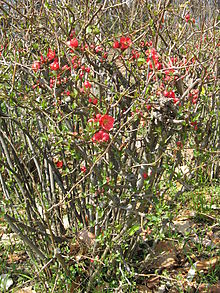- Chaenomeles speciosa
-
Not to be confused with Carica papaya, papaya, which, like Chaenomeles speciosa, is sometimes called mugua.
Chaenomeles speciosa 
Flowers of C. speciosa Scientific classification Kingdom: Plantae (unranked): Angiosperms (unranked): Eudicots (unranked): Rosids Order: Rosales Family: Rosaceae Genus: Chaenomeles Species: C. speciosa Binomial name Chaenomeles speciosa
(Sweet) Nak.Synonyms Chaenomeles lagenaria (Loisel.) Koidz.[citation needed]
Cydonia lagenaria Loisel.[citation needed]
Cydonia speciosa Sweet[citation needed]
Pyrus japonica Sims. non Thunb.[citation needed]Chaenomeles speciosa (commonly known as flowering quince or Japanese quince[1] or as mugua[citation needed] in traditional Chinese medicine[2]) is a thorny deciduous or semi-evergreen shrub native to eastern Asia. It is taller than another commonly cultivated species, C. japonica, usually growing to about 2 m.[1] The flowers are usually red, but may be white or pink, and the fruit is a fragrant but hard pome that resembles a quince.[1]
Contents
Ethnomedical uses
The fruit has been part of traditional Chinese medicine (TCM) for thousands of years, used to treat arthritis, leg edema, and cramping in the calf muscle.
Pharmacology
It has been found to be an effective and selective dopamine reuptake inhibitor.[3]
See also
- Pseudocydonia (Chaenomeles sinensis), also called mugua
- Papaya, a tropical fruit that shares the name mugua
References and external links
- ^ a b c Bailey, L.H.; Bailey, E.Z.; the staff of the Liberty Hyde Bailey Hortorium. 1976. Hortus third: A concise dictionary of plants cultivated in the United States and Canada. Macmillan, New York.
- ^ Subhuti Dharmananda 2005. "Chaenomeles: A relaxing and strengthening fruit" in Institute for Traditional Medicine database [1]
- ^ Zhao G, Jiang ZH, Zheng XW, Zang SY, Guo LH (2008). "Dopamine transporter inhibitory and antiparkinsonian effect of common flowering quince extract.". Pharmacol Biochem Behav 90 (3): 363–71. doi:10.1016/j.pbb.2008.03.014. PMID 18485464.
- article Effects and mechanisms of glucosides of chaenomeles speciosa on collagen-induced arthritis in rats
- Information from USDA PLANTS
- Information from Plants for a Future
- Information from Chinese Medicine Basics
- article Glucosides of Chaenomeles speciosa remit rat adjuvant arthritis by inhibiting synoviocyte activities
Categories:
Wikimedia Foundation. 2010.
